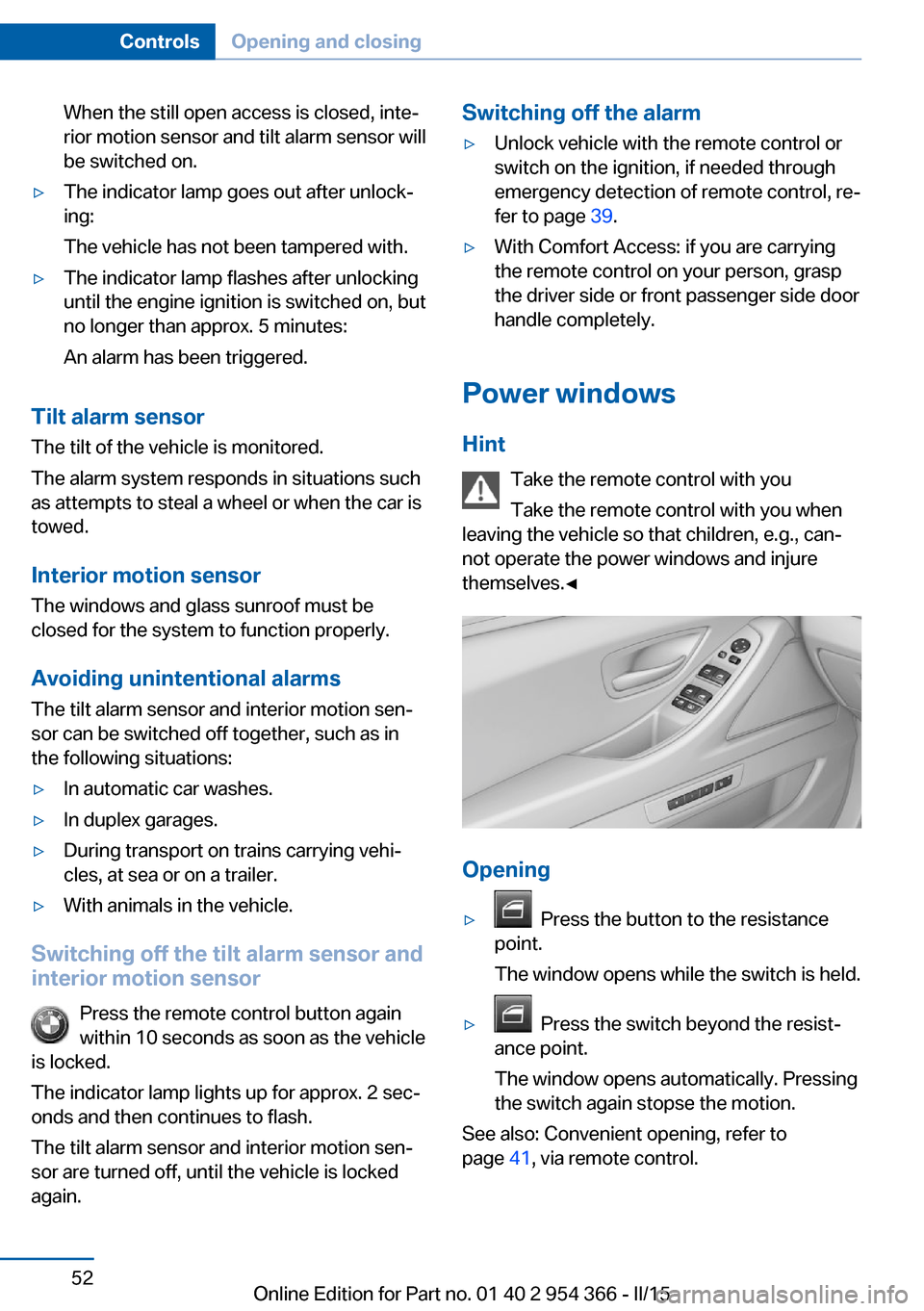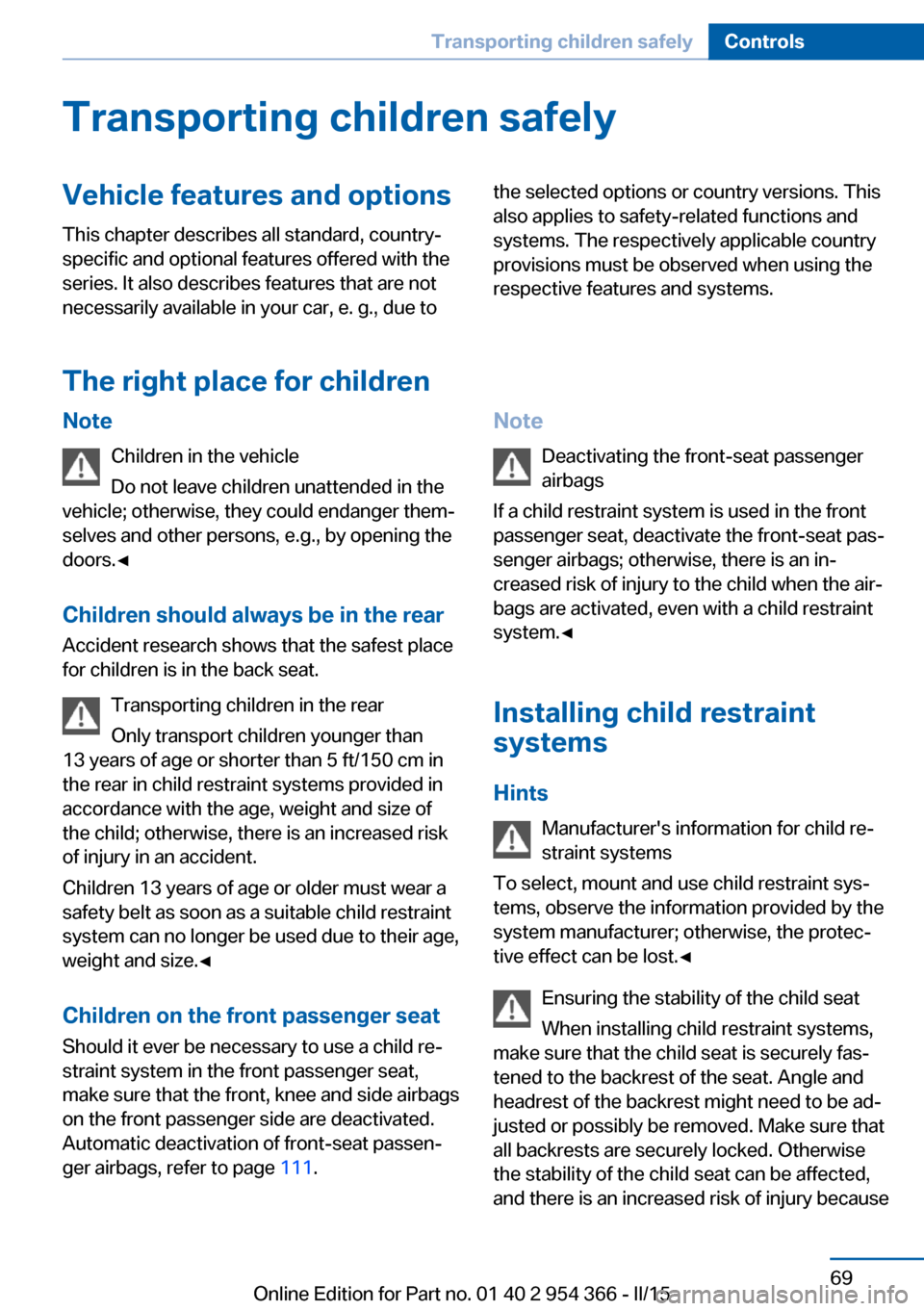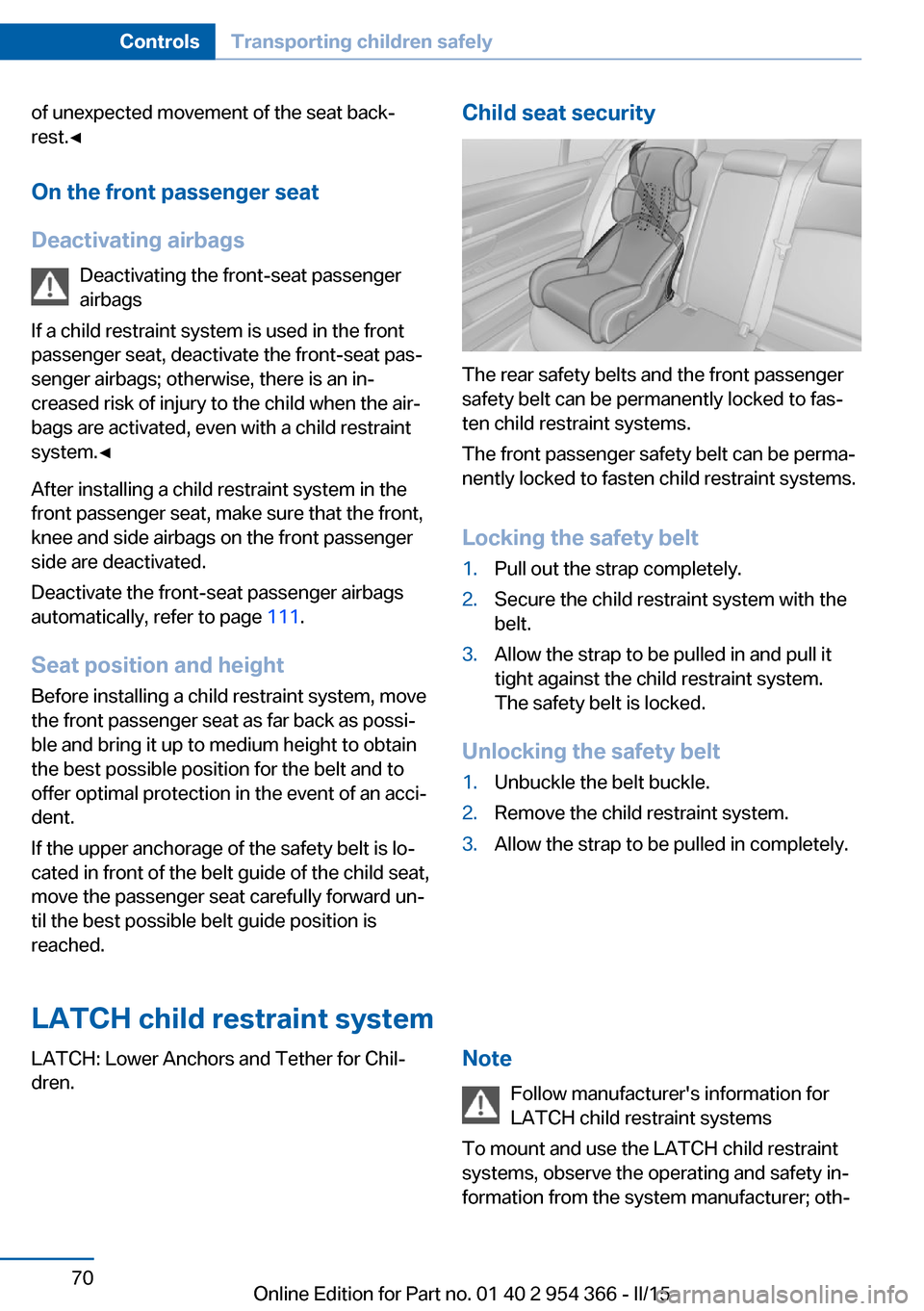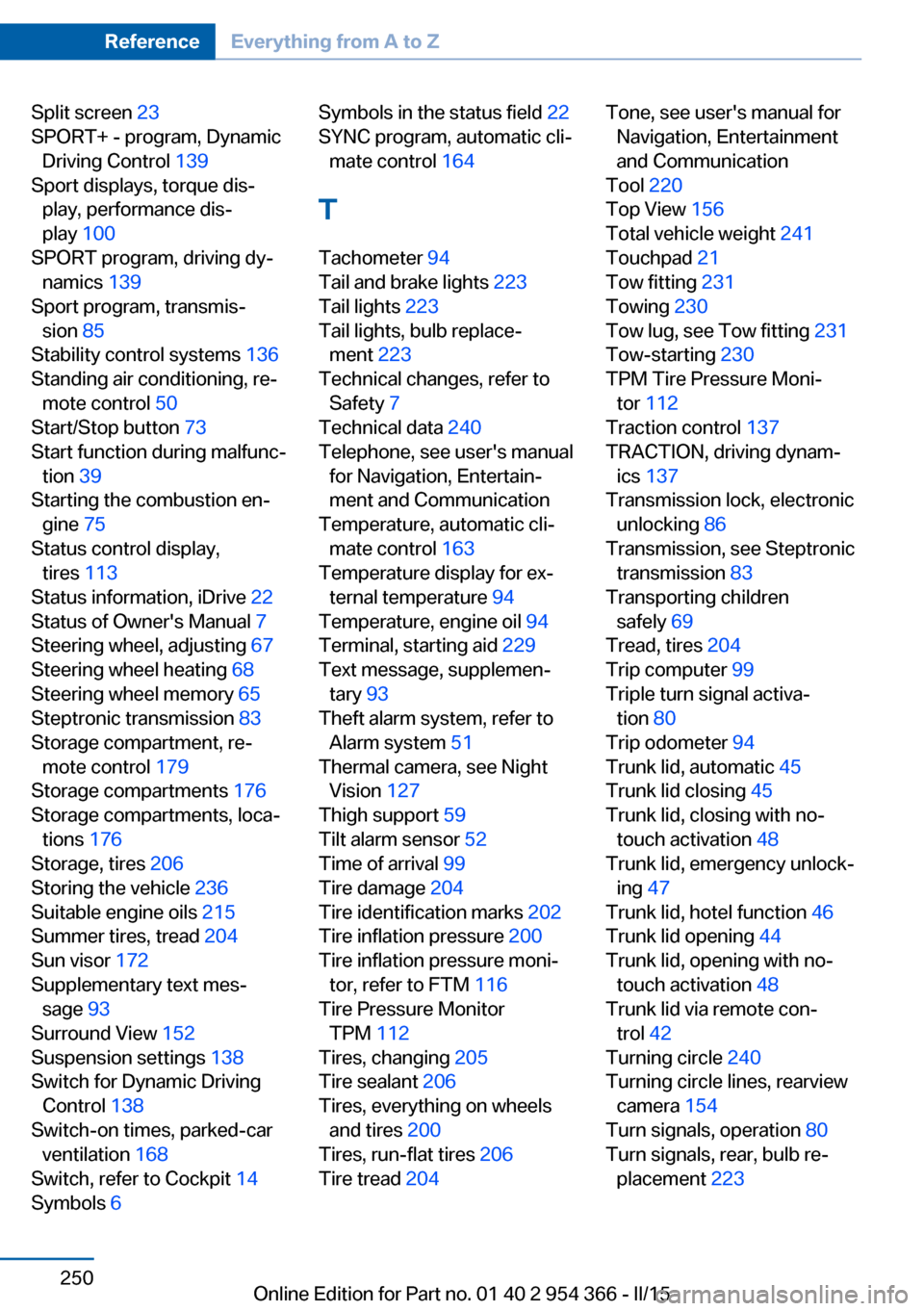child lock BMW ACTIVE HYBRID 5 2015 F10H Owner's Manual
[x] Cancel search | Manufacturer: BMW, Model Year: 2015, Model line: ACTIVE HYBRID 5, Model: BMW ACTIVE HYBRID 5 2015 F10HPages: 257, PDF Size: 5.26 MB
Page 56 of 257

When the still open access is closed, inte‐
rior motion sensor and tilt alarm sensor will
be switched on.▷The indicator lamp goes out after unlock‐
ing:
The vehicle has not been tampered with.▷The indicator lamp flashes after unlocking
until the engine ignition is switched on, but
no longer than approx. 5 minutes:
An alarm has been triggered.
Tilt alarm sensor The tilt of the vehicle is monitored.
The alarm system responds in situations such
as attempts to steal a wheel or when the car is
towed.
Interior motion sensor The windows and glass sunroof must be
closed for the system to function properly.
Avoiding unintentional alarms The tilt alarm sensor and interior motion sen‐
sor can be switched off together, such as in
the following situations:
▷In automatic car washes.▷In duplex garages.▷During transport on trains carrying vehi‐
cles, at sea or on a trailer.▷With animals in the vehicle.
Switching off the tilt alarm sensor and
interior motion sensor
Press the remote control button again
within 10 seconds as soon as the vehicle
is locked.
The indicator lamp lights up for approx. 2 sec‐
onds and then continues to flash.
The tilt alarm sensor and interior motion sen‐
sor are turned off, until the vehicle is locked again.
Switching off the alarm▷Unlock vehicle with the remote control or
switch on the ignition, if needed through
emergency detection of remote control, re‐
fer to page 39.▷With Comfort Access: if you are carrying
the remote control on your person, grasp
the driver side or front passenger side door
handle completely.
Power windows
Hint Take the remote control with you
Take the remote control with you when
leaving the vehicle so that children, e.g., can‐
not operate the power windows and injure
themselves.◀
Opening
▷ Press the button to the resistance
point.
The window opens while the switch is held.▷ Press the switch beyond the resist‐
ance point.
The window opens automatically. Pressing
the switch again stopse the motion.
See also: Convenient opening, refer to
page 41, via remote control.
Seite 52ControlsOpening and closing52
Online Edition for Part no. 01 40 2 954 366 - II/15
Page 57 of 257

ClosingKeep the closing path clear
Monitor closing and make sure that the
closing path of the window is clear; otherwise,
injuries may result.◀▷ Pull the switch to the resistance
point.
The window closes while the switch is
held.▷ Pull the switch beyond the resistance
point.
The window closes automatically. Pulling
again stops the motion.
See also: closing by means of Comfort Access,
refer to page 47.
Pinch protection system Danger of jamming even with pinch pro‐
tection
Even with the pinch protection system, check
that the window's closing path is clear; other‐
wise, the closing action may not stop in certain
situations, e.g., if thin objects are present.◀
No window accessories
Do not install any accessories in the win‐
dow's range of movement; otherwise, the
pinch protection system will be impaired.◀
If closing force exceeds a specific margin as a
window closes, closing is interrupted.
The window reopens slightly.
Closing without the pinch protection
system
Keep the closing path clear
Monitor closing and make sure that the
closing path of the window is clear; otherwise,
injuries may result.◀
E.g. danger from the outside or ice might pre‐
vent window from closing properly - proceed
as follows:1.Pull the reel past the resistance point and
hold it there.
The pinch protection is limited and the
window reopens slightly if the closing force
exceeds a certain margin.2.Pull the reel past the resistance point again
within approx. 4 seconds and hold it there.
The window closes without jam protection.
Safety switch
General information
The safety switch in the driver's door can be
used to prevent children, e.g., from opening
and closing the rear windows using the
switches in the rear.
Switching on and off Press button.
The LED lights up if the safety func‐
tion is switched on.
Safety switch for rear operationPress the safety switch when transport‐
ing children in the rear; otherwise, injury may
result if the windows are closed without super‐
vision.◀
Roller sunblinds
General information
If you are no longer able to move the roller sun‐
blind for the rear window after having activated
it a number of times in a row, the system is
blocked for a limited time to prevent overheat‐ ing. Let the system cool.
The roller sunblind for the rear window cannot
be moved at low interior temperatures.
Seite 53Opening and closingControls53
Online Edition for Part no. 01 40 2 954 366 - II/15
Page 65 of 257

The maximum temperature is reached when
three LEDs are lit.
If the journey is continued within approx. 15
minutes, the seat heating is activated automat‐
ically with the temperature selected last.
When ECO PRO, refer to page 191, is acti‐
vated, the heater output is reduced.
Switch off Press button longer.
The LEDs go out.
Active seat ventilation, front The seat cushion and backrest surfaces are
cooled by means of integrated fans.
The ventilation cools the seat, e. g., if the vehi‐
cle interior is overheated or for continuous
cooling at high temperatures.
Switching on
Press button once for each ventilation
level.
The highest level is active when three LEDs
are lit.
After a short time, the system automatically
moves down one level in order to prevent ex‐
cessive cooling.
Switch off Press button longer.
The LEDs go out.
Safety belts
Seats with safety belt
The vehicle has five seats, each of which is
equipped with a safety belt.
General information
Always make sure that safety belts are being
worn by all occupants before driving off.
For the occupants' safety the belt locking
mechanism triggers early. Slowly guide the
belt out of the holder when applying it.
Although airbags enhance safety by providing
added protection, they are not a substitute for
safety belts.
The upper shoulder strap's anchorage point
will be correct for adult seat occupants of ev‐
ery build if the seat is correctly adjusted.▷The two outer safety belt buckles,
integrated into the rear seat, are for pas‐
sengers sitting on the left and right.▷The center rear safety belt buckle is solely
intended for the center passenger.
Hints
One person per safety belt
Never allow more than one person to
wear a single safety belt. Never allow infants or
small children to ride on a passenger's lap.◀
Putting on the belt
Lay the belt, without twisting, snugly
across the lap and shoulders, as close to the
body as possible. Make sure that the belt lies
low around the hips in the lap area and does
not press on the abdomen. Otherwise, the belt
can slip over the hips in a frontal impact and in‐
jure the abdomen.
The safety belt must not lie across the neck,
rub on sharp edges, be routed over breakable
objects, or be pinched.◀
Seite 61AdjustingControls61
Online Edition for Part no. 01 40 2 954 366 - II/15
Page 73 of 257

Transporting children safelyVehicle features and optionsThis chapter describes all standard, country-
specific and optional features offered with the
series. It also describes features that are not
necessarily available in your car, e. g., due tothe selected options or country versions. This
also applies to safety-related functions and
systems. The respectively applicable country
provisions must be observed when using the
respective features and systems.
The right place for children
Note
Children in the vehicle
Do not leave children unattended in the
vehicle; otherwise, they could endanger them‐
selves and other persons, e.g., by opening the
doors.◀
Children should always be in the rear Accident research shows that the safest place
for children is in the back seat.
Transporting children in the rear
Only transport children younger than
13 years of age or shorter than 5 ft/150 cm in
the rear in child restraint systems provided in
accordance with the age, weight and size of
the child; otherwise, there is an increased risk
of injury in an accident.
Children 13 years of age or older must wear a
safety belt as soon as a suitable child restraint
system can no longer be used due to their age,
weight and size.◀
Children on the front passenger seat
Should it ever be necessary to use a child re‐
straint system in the front passenger seat,
make sure that the front, knee and side airbags
on the front passenger side are deactivated.
Automatic deactivation of front-seat passen‐
ger airbags, refer to page 111.Note
Deactivating the front-seat passenger
airbags
If a child restraint system is used in the front
passenger seat, deactivate the front-seat pas‐
senger airbags; otherwise, there is an in‐
creased risk of injury to the child when the air‐
bags are activated, even with a child restraint
system.◀
Installing child restraint
systems
Hints Manufacturer's information for child re‐straint systems
To select, mount and use child restraint sys‐
tems, observe the information provided by the
system manufacturer; otherwise, the protec‐
tive effect can be lost.◀
Ensuring the stability of the child seat
When installing child restraint systems,
make sure that the child seat is securely fas‐
tened to the backrest of the seat. Angle and
headrest of the backrest might need to be ad‐
justed or possibly be removed. Make sure that
all backrests are securely locked. Otherwise
the stability of the child seat can be affected,
and there is an increased risk of injury becauseSeite 69Transporting children safelyControls69
Online Edition for Part no. 01 40 2 954 366 - II/15
Page 74 of 257

of unexpected movement of the seat back‐
rest.◀
On the front passenger seat
Deactivating airbags Deactivating the front-seat passenger
airbags
If a child restraint system is used in the front
passenger seat, deactivate the front-seat pas‐
senger airbags; otherwise, there is an in‐
creased risk of injury to the child when the air‐
bags are activated, even with a child restraint
system.◀
After installing a child restraint system in the
front passenger seat, make sure that the front,
knee and side airbags on the front passenger
side are deactivated.
Deactivate the front-seat passenger airbags automatically, refer to page 111.
Seat position and height
Before installing a child restraint system, move
the front passenger seat as far back as possi‐
ble and bring it up to medium height to obtain
the best possible position for the belt and to
offer optimal protection in the event of an acci‐
dent.
If the upper anchorage of the safety belt is lo‐
cated in front of the belt guide of the child seat,
move the passenger seat carefully forward un‐
til the best possible belt guide position is
reached.Child seat security
The rear safety belts and the front passenger
safety belt can be permanently locked to fas‐
ten child restraint systems.
The front passenger safety belt can be perma‐
nently locked to fasten child restraint systems.
Locking the safety belt
1.Pull out the strap completely.2.Secure the child restraint system with the
belt.3.Allow the strap to be pulled in and pull it
tight against the child restraint system.
The safety belt is locked.
Unlocking the safety belt
1.Unbuckle the belt buckle.2.Remove the child restraint system.3.Allow the strap to be pulled in completely.
LATCH child restraint system
LATCH: Lower Anchors and Tether for Chil‐
dren.Note
Follow manufacturer's information for
LATCH child restraint systems
To mount and use the LATCH child restraint
systems, observe the operating and safety in‐
formation from the system manufacturer; oth‐Seite 70ControlsTransporting children safely70
Online Edition for Part no. 01 40 2 954 366 - II/15
Page 76 of 257

Attaching the upper retaining strap to
the mounting point1.Remove the mounting point cover.2.Raise the head restraint. Do not change
the middle head restraint.3.Guide the upper retaining strap between
the supports of the head restraint.
Guide it over the head restraint of the mid‐
dle seat.4.Attach the hook of the retaining strap to
the mounting eye.5.Tighten the retaining strap by pulling it
down.6.Lower and lock head restraints as needed.
Locking the doors and
windows
Rear doors
Push the locking lever on the rear doors down.
The door can now be opened from the outside
only.
Safety switch for the rear Press button on the driver's door if
children are being transported in the
rear.
This locks various functions so that they can‐
not be operated from the rear: safety switch,
refer to page 53.
Seite 72ControlsTransporting children safely72
Online Edition for Part no. 01 40 2 954 366 - II/15
Page 78 of 257

▷When locking the vehicle, and when the
low beams are activated.▷Shortly before the battery is discharged
completely, so that the engine can still be
started. This function is only available
when the low beams are turned off.▷When opening and closing the driver door,
if the driver's safety belt is unbuckled and
the low beams are turned off.▷While the driver's safety belt is unbuckled
with driver's door open and low beams off.
The low beams switch to parking lights after
approx. 15 minutes of no use.
When the ignition is switched off automatically
by opening or closing the driver's door, un‐
buckling the driver's safety belt or by the auto‐
matic switching of the low beams to parking
lights, the radio-ready state remains active.
Drive readiness
When drive readiness is activated, the vehicle
is operational. Activated drive readiness is the
equivalent of a running engine in conventional
vehicles. Deactivated engine readiness is
equivalent to switching the ignition off.
Drive readiness in detail
The concept
The following are the different drive readiness
variants:
▷Electric drive readiness, Silent Start, refer
to page 74
The vehicle is powered by the electric mo‐
tor.▷Starting the combustion engine, refer to
page 75
The vehicle is powered by the combustion
engine.Hints
Awareness of vehicle reduced when
driven in electric mode
When driving in electric mode, note that due to
the lack of engine noise pedestrians and other traffic might pay less attention to the vehicle
due to missing engine noises. Please take spe‐
cial care when parking or leaving a parking
space.◀
Do not leave the vehicle unattended
Do not leave the vehicle unattended with
drive readiness active; otherwise, it may pose a
risk.◀
Take the remote control with you
Take the remote control with you when
leaving the vehicle so that children, e.g., can‐
not start the engine.◀
Apply parking brake and further secure
the vehicle if needed.
Set the parking brake firmly when parking; oth‐
erwise, the vehicle could roll. On steep upward
and downward inclines, further secure the ve‐
hicle, e.g., by turning the steering wheel in the
direction of the curb.◀
Activating drive readiness1.Close the driver's door.2.Depress the brake pedal.3.Press the Start/Stop button.
Drive readiness is activated:
▷Electric drive readiness, Silent Start or▷Starting the combustion engine.
Electric drive readiness, Silent Start The vehicle is ready for driving without starting
the combustion engine.
Silent Start is possible if the requirements for
Electric driving, refer to page 76, are met.
Seite 74ControlsDriving74
Online Edition for Part no. 01 40 2 954 366 - II/15
Page 247 of 257

Bar for tow-starting/towing 230
Battery replacement, vehicle battery 225
Battery replacement, vehicle remote control 39
Battery, vehicle 225
Belts, safety belts 61
Beverage holder, cu‐ pholder 178
Blinds, sun protection 53
BMW ActiveHybrid 31
BMW Assist, see user's manual for Navigation, En‐
tertainment and Communi‐
cation
BMW Driver’s Guide App 6
BMW Homepage 6
BMW Internet page 6
BMW maintenance sys‐ tem 218
Bonus range, ECO PRO 192
Bottle holder, refer to Cu‐ pholder 178
Brake assistant 136
Brake assistant, adaptive 136
Brake discs, break-in 182
Brake force display 133
Brake lights, adaptive 133
Brake lights, brake force dis‐ play 133
Brake lights, bulb replace‐ ment 223
Brake pads, break-in 182
Braking, hints 185
Breakdown assistance 227
Break-in 182
Brightness of Control Dis‐ play 102
Bulb replacement 220
Bulb replacement, front 221
Bulb replacement, rear 223
Bulbs and lights 220
Button, RES 144
Button, Start/Stop 73 Bypassing, refer to Jump-
starting 228
C
California Proposition 65 Warning 8
Calling up mirror adjust‐ ment 50
Calling up seat adjust‐ ment 50
Calling up steering wheel ad‐ justment 50
Camera lenses, care 236
Camera, rearview cam‐ era 153
Camera, Side View 155
Camera, Top View 157
Can holder, refer to Cu‐ pholder 178
Car battery 225
Car care products 234
Care, displays 236
Care, vehicle 234
Cargo 187
Cargo area, storage compart‐ ments 179
Cargo, securing 188
Cargo straps, securing cargo 188
Car key, refer to Remote con‐ trol 38
Carpet, care 236
Car wash 233
Catalytic converter, refer to Hot exhaust system 184
CBS Condition Based Serv‐ ice 218
CD/Multimedia, see user's manual for Navigation, En‐
tertainment and Communi‐
cation
Center armrest 177
Center console 16
Central locking system 44 Central screen, refer to Con‐
trol Display 18
Changes, technical, refer to Safety 7
Changing parts 220
Changing wheels 225
Changing wheels/tires 205
CHARGE, energy recov‐ ery 77
Charge indicator, high-volt‐ age battery 88
Chassis number, see vehicle identification number 9
Check Control 90
Checking the engine oil level electronically 213
Checking the oil level elec‐ tronically 213
Children, seating position 69
Children, transporting safely 69
Child restraint fixing sys‐ tem 69
Child restraint fixing system LATCH 70
Child restraint fixing systems, mounting 69
Child safety locks 72
Child seat, mounting 69
Child seats 69
Chrome parts, care 235
Cigarette lighter 172
Cleaning displays 236
Climate control 162
Climate control laminated tinted safety glass 184
Climate control wind‐ shield 184
Clock 95
Closing/opening via door lock 43
Closing/opening with remote control 41
Closing the trunk lid with no- touch activation 48
Clothes hooks 179 Seite 243Everything from A to ZReference243
Online Edition for Part no. 01 40 2 954 366 - II/15
Page 251 of 257

Key Memory, refer to Per‐sonal Profile 39
Kickdown, Steptronic trans‐ mission 84
Knee airbag 110
L
Lamp replacement 220
Lamp replacement, front 221
Lamp replacement, rear 223
Lane departure warning 130
Lane margin, warning 130
Language on Control Dis‐ play 101
Lashing eyes, securing cargo 188
LATCH child restraint sys‐ tem 70
Leather, care 234
LED front fog lights, bulb re‐ placement 223
LED headlights, bulb replace‐ ment 223
LED light 223
LEDs, light-emitting di‐ odes 221
Length, vehicle 240
Letters and numbers, enter‐ ing 24
License plate lamp, bulb re‐ placement 223
Light alloy wheels, care 235
Light control 105
Light-emitting diodes, LEDs 221
Lighter, front 173
Lighter, rear 173
Lighting 104
Lighting, speaker 108
Lights 104
Lights and bulbs 220
Light switch 104
Load 188
Loading 187
Lock, door 43 Locking/unlocking via door
lock 43
Locking/unlocking with re‐ mote control 41
Locking, automatic 50
Locking, settings 50
Locking via trunk lid 45
Lock, power window 53
Locks, doors, and win‐ dows 72
Low beams 104
Low beams, automatic, refer to High-beam Assistant 106
Lower back support 59
Luggage rack, see Roof- mounted luggage rack 188
Lumbar support 59
M
Maintenance 218
Maintenance require‐ ments 218
Maintenance, service require‐ ments 95
Maintenance system, BMW 218
Make-up mirror 172
Malfunction displays, see Check Control 90
Manual air distribution 163
Manual air flow 163
Manual brake, refer to Parking brake 77
Manual mode, Steptronic transmission 85
Manual operation, door lock 43
Manual operation, exterior mirrors 66
Manual operation, fuel filler flap 197
Manual operation, Park Dis‐ tance Control PDC 151
Manual operation, rearview camera 153 Manual operation, Side
View 156
Manual operation, Top View 157
Marking on approved tires 205
Marking, run-flat tires 206
Massage seat, front 60
Master key, refer to Remote control 38
Maximum cooling 164
Maximum speed, display 96
Maximum speed, winter tires 206
Measure, units of 102
Medical kit 228
Memory for seat, mirrors, steering wheel 65
Menu in instrument clus‐ ter 98
Menus, operating, iDrive 18
Menus, refer to iDrive operat‐ ing concept 19
Messages, see Check Con‐ trol 90
Microfilter 165
Minimum tread, tires 204
Mirror 66
Mirror memory 65
Mobile communication devi‐ ces in the vehicle 185
Mobility System 206
Modifications, technical, refer to Safety 7
Moisture in headlight 221
Monitor, refer to Control Dis‐ play 18
Mounting of child restraint systems 69
Multifunction steering wheel, buttons 14 Seite 247Everything from A to ZReference247
Online Edition for Part no. 01 40 2 954 366 - II/15
Page 254 of 257

Split screen 23
SPORT+ - program, Dynamic Driving Control 139
Sport displays, torque dis‐ play, performance dis‐
play 100
SPORT program, driving dy‐ namics 139
Sport program, transmis‐ sion 85
Stability control systems 136
Standing air conditioning, re‐ mote control 50
Start/Stop button 73
Start function during malfunc‐ tion 39
Starting the combustion en‐ gine 75
Status control display, tires 113
Status information, iDrive 22
Status of Owner's Manual 7
Steering wheel, adjusting 67
Steering wheel heating 68
Steering wheel memory 65
Steptronic transmission 83
Storage compartment, re‐ mote control 179
Storage compartments 176
Storage compartments, loca‐ tions 176
Storage, tires 206
Storing the vehicle 236
Suitable engine oils 215
Summer tires, tread 204
Sun visor 172
Supplementary text mes‐ sage 93
Surround View 152
Suspension settings 138
Switch for Dynamic Driving Control 138
Switch-on times, parked-car ventilation 168
Switch, refer to Cockpit 14
Symbols 6 Symbols in the status field 22
SYNC program, automatic cli‐ mate control 164
T Tachometer 94
Tail and brake lights 223
Tail lights 223
Tail lights, bulb replace‐ ment 223
Technical changes, refer to Safety 7
Technical data 240
Telephone, see user's manual for Navigation, Entertain‐
ment and Communication
Temperature, automatic cli‐ mate control 163
Temperature display for ex‐ ternal temperature 94
Temperature, engine oil 94
Terminal, starting aid 229
Text message, supplemen‐ tary 93
Theft alarm system, refer to Alarm system 51
Thermal camera, see Night Vision 127
Thigh support 59
Tilt alarm sensor 52
Time of arrival 99
Tire damage 204
Tire identification marks 202
Tire inflation pressure 200
Tire inflation pressure moni‐ tor, refer to FTM 116
Tire Pressure Monitor TPM 112
Tires, changing 205
Tire sealant 206
Tires, everything on wheels and tires 200
Tires, run-flat tires 206
Tire tread 204 Tone, see user's manual for
Navigation, Entertainment
and Communication
Tool 220
Top View 156
Total vehicle weight 241
Touchpad 21
Tow fitting 231
Towing 230
Tow lug, see Tow fitting 231
Tow-starting 230
TPM Tire Pressure Moni‐ tor 112
Traction control 137
TRACTION, driving dynam‐ ics 137
Transmission lock, electronic unlocking 86
Transmission, see Steptronic transmission 83
Transporting children safely 69
Tread, tires 204
Trip computer 99
Triple turn signal activa‐ tion 80
Trip odometer 94
Trunk lid, automatic 45
Trunk lid closing 45
Trunk lid, closing with no- touch activation 48
Trunk lid, emergency unlock‐ ing 47
Trunk lid, hotel function 46
Trunk lid opening 44
Trunk lid, opening with no- touch activation 48
Trunk lid via remote con‐ trol 42
Turning circle 240
Turning circle lines, rearview camera 154
Turn signals, operation 80
Turn signals, rear, bulb re‐ placement 223 Seite 250ReferenceEverything from A to Z250
Online Edition for Part no. 01 40 2 954 366 - II/15